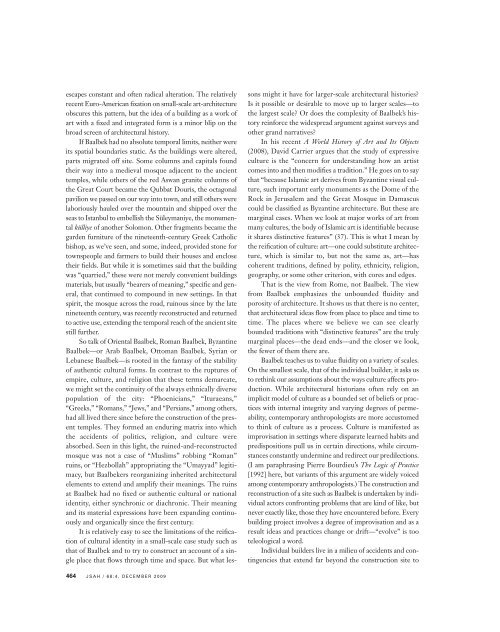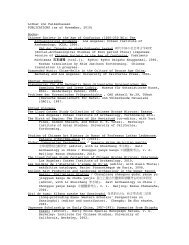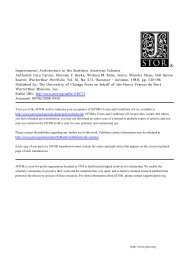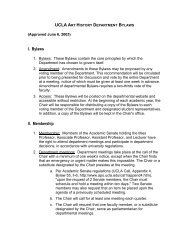Noah, Solomon, Saladin and the Fluidity of Architecture
Noah, Solomon, Saladin and the Fluidity of Architecture
Noah, Solomon, Saladin and the Fluidity of Architecture
Create successful ePaper yourself
Turn your PDF publications into a flip-book with our unique Google optimized e-Paper software.
escapes constant <strong>and</strong> <strong>of</strong>ten radical alteration. The relatively<br />
recent Euro-American fixation on small-scale art-architecture<br />
obscures this pattern, but <strong>the</strong> idea <strong>of</strong> a building as a work <strong>of</strong><br />
art with a fixed <strong>and</strong> integrated form is a minor blip on <strong>the</strong><br />
broad screen <strong>of</strong> architectural history.<br />
If Baalbek had no absolute temporal limits, nei<strong>the</strong>r were<br />
its spatial boundaries static. As <strong>the</strong> buildings were altered,<br />
parts migrated <strong>of</strong>f site. Some columns <strong>and</strong> capitals found<br />
<strong>the</strong>ir way into a medieval mosque adjacent to <strong>the</strong> ancient<br />
temples, while o<strong>the</strong>rs <strong>of</strong> <strong>the</strong> red Aswan granite columns <strong>of</strong><br />
<strong>the</strong> Great Court became <strong>the</strong> Qubbat Douris, <strong>the</strong> octagonal<br />
pavilion we passed on our way into town, <strong>and</strong> still o<strong>the</strong>rs were<br />
laboriously hauled over <strong>the</strong> mountain <strong>and</strong> shipped over <strong>the</strong><br />
seas to Istanbul to embellish <strong>the</strong> Süleymaniye, <strong>the</strong> monumental<br />
külliye <strong>of</strong> ano<strong>the</strong>r <strong>Solomon</strong>. O<strong>the</strong>r fragments became <strong>the</strong><br />
garden furniture <strong>of</strong> <strong>the</strong> nineteenth-century Greek Catholic<br />
bishop, as we’ve seen, <strong>and</strong> some, indeed, provided stone for<br />
townspeople <strong>and</strong> farmers to build <strong>the</strong>ir houses <strong>and</strong> enclose<br />
<strong>the</strong>ir fields. But while it is sometimes said that <strong>the</strong> building<br />
was “quarried,” <strong>the</strong>se were not merely convenient buildings<br />
materials, but usually “bearers <strong>of</strong> meaning,” specific <strong>and</strong> general,<br />
that continued to compound in new settings. In that<br />
spirit, <strong>the</strong> mosque across <strong>the</strong> road, ruinous since by <strong>the</strong> late<br />
nineteenth century, was recently reconstructed <strong>and</strong> returned<br />
to active use, extending <strong>the</strong> temporal reach <strong>of</strong> <strong>the</strong> ancient site<br />
still fur<strong>the</strong>r.<br />
So talk <strong>of</strong> Oriental Baalbek, Roman Baalbek, Byzantine<br />
Baalbek—or Arab Baalbek, Ottoman Baalbek, Syrian or<br />
Lebanese Baalbek—is rooted in <strong>the</strong> fantasy <strong>of</strong> <strong>the</strong> stability<br />
<strong>of</strong> au<strong>the</strong>ntic cultural forms. In contrast to <strong>the</strong> ruptures <strong>of</strong><br />
empire, culture, <strong>and</strong> religion that <strong>the</strong>se terms demarcate,<br />
we might set <strong>the</strong> continuity <strong>of</strong> <strong>the</strong> always ethnically diverse<br />
population <strong>of</strong> <strong>the</strong> city: “Phoenicians,” “Ituraeans,”<br />
“Greeks,” “Romans,” “Jews,” <strong>and</strong> “Persians,” among o<strong>the</strong>rs,<br />
had all lived <strong>the</strong>re since before <strong>the</strong> construction <strong>of</strong> <strong>the</strong> present<br />
temples. They formed an enduring matrix into which<br />
<strong>the</strong> accidents <strong>of</strong> politics, religion, <strong>and</strong> culture were<br />
absorbed. Seen in this light, <strong>the</strong> ruined-<strong>and</strong>-reconstructed<br />
mosque was not a case <strong>of</strong> “Muslims” robbing “Roman”<br />
ruins, or “Hezbollah” appropriating <strong>the</strong> “Umayyad” legitimacy,<br />
but Baalbekers reorganizing inherited architectural<br />
elements to extend <strong>and</strong> amplify <strong>the</strong>ir meanings. The ruins<br />
at Baalbek had no fixed or au<strong>the</strong>ntic cultural or national<br />
identity, ei<strong>the</strong>r synchronic or diachronic. Their meaning<br />
<strong>and</strong> its material expressions have been exp<strong>and</strong>ing continuously<br />
<strong>and</strong> organically since <strong>the</strong> first century.<br />
It is relatively easy to see <strong>the</strong> limitations <strong>of</strong> <strong>the</strong> reification<br />
<strong>of</strong> cultural identity in a small-scale case study such as<br />
that <strong>of</strong> Baalbek <strong>and</strong> to try to construct an account <strong>of</strong> a single<br />
place that flows through time <strong>and</strong> space. But what lessons<br />
might it have for larger-scale architectural histories?<br />
Is it possible or desirable to move up to larger scales—to<br />
<strong>the</strong> largest scale? Or does <strong>the</strong> complexity <strong>of</strong> Baalbek’s history<br />
reinforce <strong>the</strong> widespread argument against surveys <strong>and</strong><br />
o<strong>the</strong>r gr<strong>and</strong> narratives?<br />
In his recent A World History <strong>of</strong> Art <strong>and</strong> Its Objects<br />
(2008), David Carrier argues that <strong>the</strong> study <strong>of</strong> expressive<br />
culture is <strong>the</strong> “concern for underst<strong>and</strong>ing how an artist<br />
comes into <strong>and</strong> <strong>the</strong>n modifies a tradition.” He goes on to say<br />
that “because Islamic art derives from Byzantine visual culture,<br />
such important early monuments as <strong>the</strong> Dome <strong>of</strong> <strong>the</strong><br />
Rock in Jerusalem <strong>and</strong> <strong>the</strong> Great Mosque in Damascus<br />
could be classified as Byzantine architecture. But <strong>the</strong>se are<br />
marginal cases. When we look at major works <strong>of</strong> art from<br />
many cultures, <strong>the</strong> body <strong>of</strong> Islamic art is identifiable because<br />
it shares distinctive features” (37). This is what I mean by<br />
<strong>the</strong> reification <strong>of</strong> culture: art—one could substitute architecture,<br />
which is similar to, but not <strong>the</strong> same as, art—has<br />
coherent traditions, defined by polity, ethnicity, religion,<br />
geography, or some o<strong>the</strong>r criterion, with cores <strong>and</strong> edges.<br />
That is <strong>the</strong> view from Rome, not Baalbek. The view<br />
from Baalbek emphasizes <strong>the</strong> unbounded fluidity <strong>and</strong><br />
porosity <strong>of</strong> architecture. It shows us that <strong>the</strong>re is no center,<br />
that architectural ideas flow from place to place <strong>and</strong> time to<br />
time. The places where we believe we can see clearly<br />
bounded traditions with “distinctive features” are <strong>the</strong> truly<br />
marginal places—<strong>the</strong> dead ends—<strong>and</strong> <strong>the</strong> closer we look,<br />
<strong>the</strong> fewer <strong>of</strong> <strong>the</strong>m <strong>the</strong>re are.<br />
Baalbek teaches us to value fluidity on a variety <strong>of</strong> scales.<br />
On <strong>the</strong> smallest scale, that <strong>of</strong> <strong>the</strong> individual builder, it asks us<br />
to rethink our assumptions about <strong>the</strong> ways culture affects production.<br />
While architectural historians <strong>of</strong>ten rely on an<br />
implicit model <strong>of</strong> culture as a bounded set <strong>of</strong> beliefs or practices<br />
with internal integrity <strong>and</strong> varying degrees <strong>of</strong> permeability,<br />
contemporary anthropologists are more accustomed<br />
to think <strong>of</strong> culture as a process. Culture is manifested as<br />
improvisation in settings where disparate learned habits <strong>and</strong><br />
predispositions pull us in certain directions, while circumstances<br />
constantly undermine <strong>and</strong> redirect our predilections.<br />
(I am paraphrasing Pierre Bourdieu’s The Logic <strong>of</strong> Practice<br />
[1992] here, but variants <strong>of</strong> this argument are widely voiced<br />
among contemporary anthropologists.) The construction <strong>and</strong><br />
reconstruction <strong>of</strong> a site such as Baalbek is undertaken by individual<br />
actors confronting problems that are kind <strong>of</strong> like, but<br />
never exactly like, those <strong>the</strong>y have encountered before. Every<br />
building project involves a degree <strong>of</strong> improvisation <strong>and</strong> as a<br />
result ideas <strong>and</strong> practices change or drift—“evolve” is too<br />
teleological a word.<br />
Individual builders live in a milieu <strong>of</strong> accidents <strong>and</strong> contingencies<br />
that extend far beyond <strong>the</strong> construction site to<br />
464 JSAH / 68:4, DECEMBER 2009





